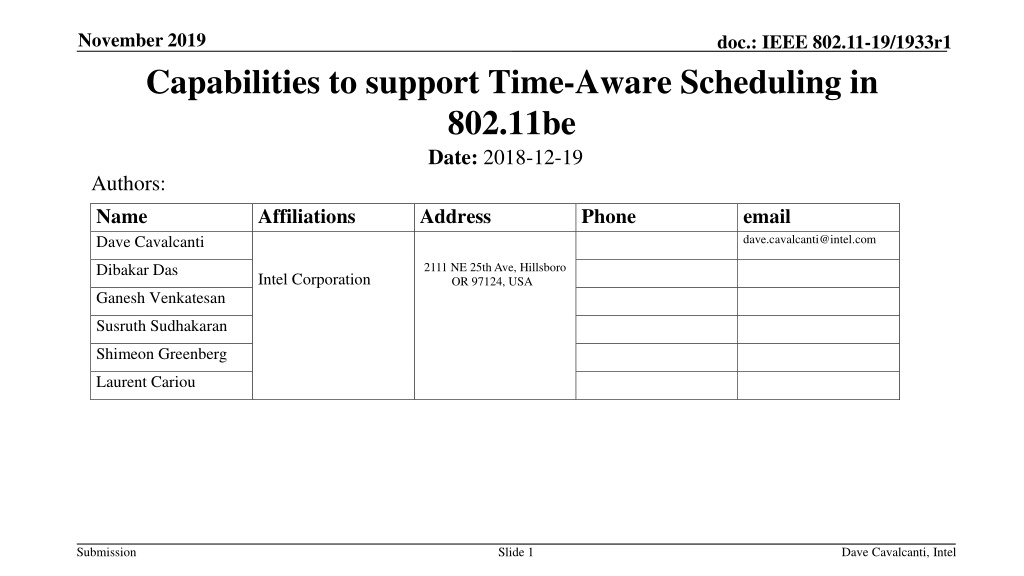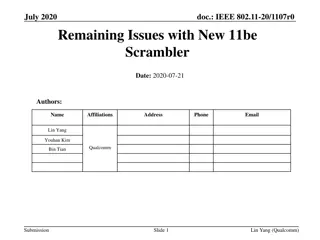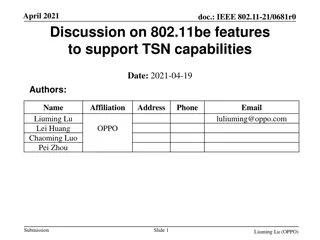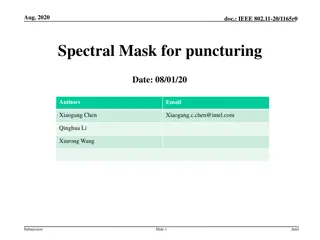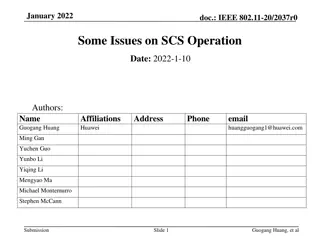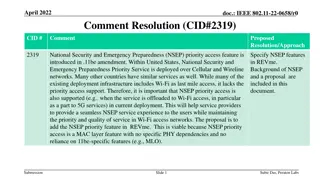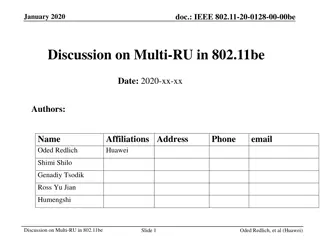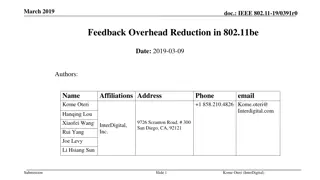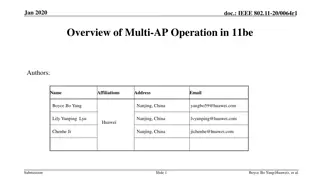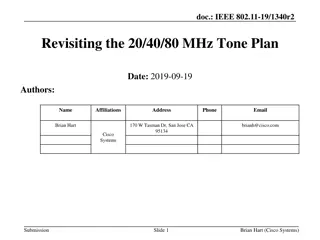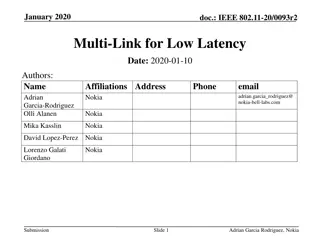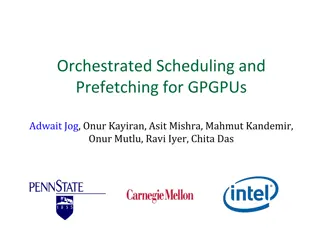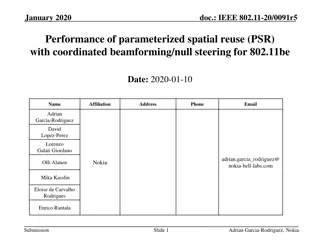Time-Aware Scheduling Capabilities in IEEE 802.11be
Describing necessary enhancements to enable Time-Aware Scheduling in IEEE 802.11be for time-sensitive applications. The focus is on aligning with the 802.1Qbv standard to address latency, jitter, and reliability issues, presenting a structured outline of requirements and configurations essential for efficient scheduling over 802.11. The content discusses TSN components, standards, and operational models associated with Time-Aware scheduling within the IEEE framework.
Download Presentation

Please find below an Image/Link to download the presentation.
The content on the website is provided AS IS for your information and personal use only. It may not be sold, licensed, or shared on other websites without obtaining consent from the author. Download presentation by click this link. If you encounter any issues during the download, it is possible that the publisher has removed the file from their server.
E N D
Presentation Transcript
November 2019 doc.: IEEE 802.11-19/1933r1 Capabilities to support Time-Aware Scheduling in 802.11be Date: 2018-12-19 Authors: Name Dave Cavalcanti Affiliations Intel Corporation Address Phone email dave.cavalcanti@intel.com 2111 NE 25th Ave, Hillsboro OR 97124, USA Dibakar Das Ganesh Venkatesan Susruth Sudhakaran Shimeon Greenberg Laurent Cariou Submission Slide 1 Dave Cavalcanti, Intel
November 2019 doc.: IEEE 802.11-19/1933r1 Abstract This presentation describes gaps and new capabilities required to enable Time-Aware scheduling over the 802.11be for time-sensitive and real-time applications. The presentation focuses on Time-Aware scheduling as defined by the 802.1Qbv standard, but the concepts and solutions described may also be applicable more generally. Submission Slide 2 Dave Cavalcanti, Intel
November 2019 doc.: IEEE 802.11-19/1933r1 Outline TSN and Time-Aware scheduling Issues and new requirements in mapping Time-Aware scheduling over 802.11 Part 1: Time-Aware (802.1Qbv) scheduling configuration over 802.11 Part 2: Time-Aware schedule execution enhancements (latency, jitter, reliability) Conclusions Submission Slide 3 Dave Cavalcanti, Intel
November 2019 doc.: IEEE 802.11-19/1933r1 IEEE 802.1 Time-Sensitive Networking (TSN) Standard Ethernet with Synchronization, small and/or fixed latency, and extremely low packet loss TSN Components Common Standards Time synchronization: Time Synchronization (802.1AS) 802.1AS over 802.11 Timing Measurement (TM) Fine Timing Measurements (FTM) Ultra reliability: Frame Replication and Elimination (P802.1CB) Path Control and Reservation (802.1Qca) Per-Stream Filtering and Policing (802.1Qci) Reliability for time sync (P802.1AS-Rev) Synchronization Reliability Reliability Latency Bounded low latency: Time-Aware traffic shaping (802.1Qbv) Preemption (802.1Qbu/802.3br) Cyclic Scheduling (802.1Qch) Asynchronous Scheduling (802.1Qcr) Dedicated resources & API Stream Reservation Protocol (802.1Qat) TSN configuration (P802.1Qcc) YANG (P802.1Qcp) Link-local Registration Protocol (P802.1CS) Resource Mgmt Zero congestion loss Time-Aware scheduling (802.1Qbv) over 802.11 (extension to address bounded latency for scheduled traffic) 802.11aa (SRP over 802.11 for AV) 802.11ak (802.11 links in an 802.1Q network) Credit: J nos Farkas, Ericsson TSNA Conference 2017, http://www.tsnaconference.com/ Submission Slide 4 Dave Cavalcanti, Intel
November 2019 doc.: IEEE 802.11-19/1933r1 Time-Aware (Qbv) Scheduling Operation model & Assumptions 802.1Qcc Centralized Model Assumptions: Time-critical traffic streams (max packet size and inter-arrival time) are known a priori (at configuration stage) CNC CUC The IEEE 802.1Qcc std defines management models (the centralized model is assumed here, other models are also possible) All TSN devices are synchronized to the same reference clock (through 802.1AS) The CUC collects the traffic stream requirements from end devices (Talkers/Listeners) and the CNC discovers the network topology The CNC computes the transmission schedule and the end to end path for each traffic stream and communicate the schedule to the CUC The CNC configures the schedule at TSN Bridges and the CUC configures the schedule in the end devices (e.g. via control plane using YANG/NETCONF) End Device End Device TSN Bridge Wired TSN Domain End Device End Device Wireless TSN Access Point Wireless TSN Domain Considerations 802.11 Access Points can be seen as Wireless TSN Bridges STAs can be configured as talkers or listeners The CUC/CNC need to coordinate with the WTSN domain (scheduling over wireless is within the 802.11 scope, but it needs to align with the overall CNC schedule) Wireless TSN Domain CUC: Central User Configuration CNC: Central Network Configuration Control plane (logical connection) between CUC and End Devices Control plane (logical connection) between CNC and TSN bridges Submission Slide 5 Dave Cavalcanti, Intel
November 2019 doc.: IEEE 802.11-19/1933r1 Parameters and Example Schedule SetGateStates: State: C O O O O O O O TC : 7 6 5 4 3 2 1 0 SetGateStates: State: 0 C C C C C C C TC : 7 6 5 4 3 2 1 0 SetGateStates: State: C C C C C C C C TC : 7 6 5 4 3 2 1 0 8021.Q Traffic Classes (defined by PCP field in a VLAN Tag) to Queues Mapping on a TSN Bridge Traffic Class #7 Traffic Class #6 Traffic Class #5 Traffic Class #0 - - T2 T0 T1 Cycle Timing Data Gate Control Time-critical Traffic Gate Gate Gate Gate TC#7 TC#6 Transmission Selection TC#5 TC#4 Cycle: list of gate operations (SetGateStates), where each operation has a time delay (Gate Open Duration). The sequence of gate operations terminates at the end of the list and re-starts OperCycleTime after the start of the sequence. TC#3 TC#2 TC#1 TC#0 Guard-band protects time-critical traffic (the guard band behavior is inherent in the defined behavior of the gates, i.e., no explicit guard band is defined in the Qbv specification) Gate Open Duration for other (non-protected) traffic classes (TC#0-6) Gate Open Duration for Time-critical Traffic (TC#7) Guard band The Time-Aware scheduling behavior must be enforced at the MAC (e.g. 802.3 or 802.11) Time critical traffic can be protected by a guard band The Time-Aware scheduling behavior have to coexist/align with the 802.11 access mechanisms (e.g. EDCA and trigger-based access) Submission Slide 6 Dave Cavalcanti, Intel
November 2019 doc.: IEEE 802.11-19/1933r1 Features required to support Time-Aware Scheduling Time synchronization Support for 802.1AS time synchronization is already enabled by 802.11 TM and FTM Classification and mapping packets of a traffic stream to a traffic class (aligned with 802.1Q traffic classification) 802.1Q and TCLAS traffic mapping capabilities defined in the 802.11 spec Enable a STA to receive a time-aware schedule request from the higher layer at the 802.11 MAC The schedule is used by the 802.11 MAC to control medium access and serve the traffic streams The 802.11 MAC may accept or reject the request (the decision is implementation specific) Enable execution of a time-aware schedule, i.e., deliver packets with certain deadlines (bounded latency) at requested time intervals The 802.11 MAC needs to provide predictable access to certain packets (preferably with high reliability) and enable non-AP STAs to request such service based on a higher layer trigger The time-aware schedule needs to take into account dynamic link states in 802.11 (negotiation with the higher layer may be required topic for collaboration between 802.1 and 802.11) Slide 7 Submission Dave Cavalcanti, Intel
November 2019 doc.: IEEE 802.11-19/1933r1 Part 1: Time-Aware Schedule Configuration over 802.11 Submission Slide 8 Dave Cavalcanti, Intel
November 2019 doc.: IEEE 802.11-19/1933r1 Time-Aware Schedule Configuration Extensions Qbv Schedule Computation: Traffic requirements are known (max pkt size, inter-arrival time) The CNC uses the link speed to create the schedule For Ethernet: The CNC assumes a fixed link speed (e.g. 1 Gbps) to compute the gate open duration for a given max packet size; For wireless/802.11: the CNC needs an estimate of time- aware scheduling support provided by the 802.11 MAC (worst-case latency for a given max packet size at predictable time intervals) Information about 802.11 capabilities could be added as part of Qbv configuration (802.1Qbv parameters wireless links) topic for collaboration between 802.1TSN and 802.11 The CNC can define a schedule and request the 802.11 devices (AP and STAs) to execute it, 802.11 devices need to indicate whether they can meet the requested schedule Need a management interface at the 802.11 MAC and primitives to accept/negotiate a Time-Aware Scheduling request from the higher (Qbv) layer 802.1Qcc Centralized Model CUC CNC End Device TSN Talker End Device TSN Switch Wired TSN Domain End Device End Device Wireless TSN Access Point TSN Listener Wireless TSN Domain CUC: Central User Configuration CNC: Central Network Configuration Submission Slide 9 Dave Cavalcanti, Intel
November 2019 doc.: IEEE 802.11-19/1933r1 Time-Aware Schedule Configuration over 802.11 Outside 802.11 scope 802.1Q TSN mngmt entity 802.11 MLME SAP Qbv Schedule Config (e.g. from CNC) The AP decides whether it can serve the traffic streams according to the requested schedule. TASched.Request TASched.Response Qbv Schedule Config Response (e.g. to CNC) Non-AP STAs need to request the AP to be served according to the TA Schedule before responding. T0 Example TAS T0+ 10ms 1 ms 500 s (Guard band) 8.5 ms (gate open) Other traffic (gate open) Time-critical Dave Cavalcanti, Intel Submission Slide 10
November 2019 doc.: IEEE 802.11-19/1933r1 STA initiated Time-Aware Scheduling Request (e.g. STA Talker scenario) Non-AP STA MLME SAP AP MLME SAP The AP decides whether it can serve the traffic streams according to the requested schedule. TASched.Request TAS.Request (TAS) T0 Example TAS T0+ 10ms 1 ms 500 s (Guard band) 8.5 ms (gate open) Other traffic (gate open) Time-critical TAS.Response ( ) TASched.Response STA responds to the higher layer based on the result of the negotiation with the AP Dave Cavalcanti, Intel Submission Slide 11
November 2019 doc.: IEEE 802.11-19/1933r1 Summary of Gaps and Potential Solutions How to inform the 802.11 MAC of a Time-Aware (Qbv) Schedule request from the SME? A new MLME MLME-TA-SCHEDULE.Request (TAS). How to inform the AP of a STA s requested schedule? The STA can use the schedule information to generate a request to be served according to a certain service period (for a max packet size and inter-arrival time) The STA can use a new procedure or updated procedures (e.g. ADDTS Request/Response, TWT setup, ) If the AP agrees to schedule the STA as requested, the STA can confirm the upper layer request, otherwise, the STA declines the upper layer time-aware scheduling request The AP is responsible for scheduling DL and UL resources (if trigger-based mode is used), STAs can apply the schedule on top of their own queues (if non-trigger-based mode is used) How to ensure packet prioritization and latency bounds are met by the 802.11 MAC? Introduce the concept of a Time-Awareness within the 802.11 MAC to differentiate and prioritize channel access based on an agreed Time-Aware schedule Slide 12 Submission Dave Cavalcanti, Intel
November 2019 doc.: IEEE 802.11-19/1933r1 Time-aware scheduling support via enhanced AddTS Request/Response Non-AP STA MAC AP STA SME AP STA MAC Non-AP STA SME MLME-AddTS.Request (TSPEC, TCLAS:VID, TAS) AddTS Request MLME-AddTS.Indication TAS Cycle MLME-AddTS.Response SP for Time-critical traffic Indicates that the AP agrees to serve the STA according to the requested schedule. AddTS Response MLME-AddTS.Confirm (TSPEC: TSID TCLAS: UP) : Guard band : Gate Open (Time-critical) : Gate Open (Other traffic) Submission Slide 13 Dave Cavalcanti, Intel
November 2019 doc.: IEEE 802.11-19/1933r1 Additional considerations Other 802.11 mechanisms could also be used in combination with the time- aware scheduling support, e.g. If the STA has time-critical and other types of traffic, the TWT SP could help align the periods to save power Note: Traffic prioritization within a TWT SP is still according to the Qbv schedule. TWT SP for time-critical + other traffic TWT SP for Time-critical traffic : Guard band : Gate Open (Time-critical) : Gate Open (Other traffic) Submission Slide 14 Dave Cavalcanti, Intel
November 2019 doc.: IEEE 802.11-19/1933r1 Part 2: Time-Aware Schedule Execution Enhancements (latency, jitter, reliability) over 802.11 Submission Slide 15 Dave Cavalcanti, Intel
November 2019 doc.: IEEE 802.11-19/1933r1 Issues if the 802.11 MAC is not aware of time-critical packets and their required transmission schedule Time-sensitive frame Assuming the high priority AC is selected for the scheduled time-critical traffic On average, high priority AC should get faster access, but a time-critical frame may still wait in some situations, e.g.: other ACs get access first (as backoffs run independently) other non-time critical (e.g. voice) frames mapped to the same AC is ahead in the queue ongoing (long) TXOP before the scheduled time Main gaps: 1. Lack of protection for time-critical traffic, i.e., prevent other traffic from accessing the medium at certain times 2. Provide access at scheduled time for time-critical frames with minimal access delay and jitter Time-sensitive frame TXOP (AC_VI) Submission Slide 16 Dave Cavalcanti, Intel
November 2019 doc.: IEEE 802.11-19/1933r1 Making the 802.11 MAC time-aware A Time-Aware schedule is defined by upper layer and passed to the 802.11 MAC via the SME-MLME-SAP interface Time-critical traffic identified by a given traffic class is mapped to a TID associated with a TSN Queue, other traffic is mapped to other EDCA queues If multiple flows are time critical, they can share one queue or multiple TSN queues can be created; 802.11be may define a mapping of TCs to 802.11 TID/TSN Queue when time-aware scheduling is used A Time-Aware Shaper (TAS) Function receives the TA Schedule from the Higher Layer The TAS Function pauses/resumes EDCAFs to avoid contention and protect the time-critical traffic according to the TAS (e.g. when the TSN queue is open, other queues are paused) A frame selection function (implementation dependent) selects frame(s) for transmission based on their priorities Higher (Qbv) Layer (TAS = GateControlList) SME-MLME SAP Time-Aware Shaper Function Time-sensitive frame selection Pause/Resume EDCAFs TSN Submission Slide 17 Dave Cavalcanti, Intel
November 2019 doc.: IEEE 802.11-19/1933r1 TSN Channel Access The TSN Queue follows access rules to minimize latency and jitter, different modes may be enabled: Trigger-based: AP controls access in the DL and UL, STA and AP negotiate on expected service periods that are aligned with the Qbv schedule EDCA-based: regular EDCA access behavior (e.g. access parameters TBD) TSN Access: Trigger based or EDCA T4 T3 T2 T0 T1 guard band Time- critical TC#7 -> TSN TC#6 -> VO Example TC to 802.11 Queue mapping and Schedule TC#5 -> VI TC#4 BE TC#3 TC#2 BK TC#1 TC#0 Regular operation, channel access policing is applied by the Time-Aware Shaper Function Submission Slide 18 Dave Cavalcanti, Intel
November 2019 doc.: IEEE 802.11-19/1933r1 Impact of unmanaged BSSs Time-Aware scheduling operates on managed STAs Interfering transmissions may impact the capability to guarantee bounded latency Unmanaged STAs/OBSSs are seen as interference The AP can take into account the level of interference when accepting/admitting TA schedules and defining SP durations Latency bound vs. capacity tradeoffs will depend on the level of interference and deployment scenario Submission Slide 19 Dave Cavalcanti, Intel
November 2019 doc.: IEEE 802.11-19/1933r1 Summary of the new requirements to support Time- Aware Scheduling over 802.11be Interface to receive a time-aware schedule request from the higher layer Mechanism for STAs to request the AP to be served according to a time-aware schedule Time-awareness for policing channel access according to an agreed time-aware schedule Low latency access for time-critical frames (once the gate is open) and differentiation from other traffic classes trigger based access can help provide predictable access and control worst-case latency Submission Slide 20 Dave Cavalcanti, Intel
November 2019 doc.: IEEE 802.11-19/1933r1 Conclusions Time-Aware scheduling is a key capability to control congestion and worst case latency One important requirements for 802.11be is to differentiate (known) time-critical streams from other traffic and serve them with predictable worst-case latency This capability will also enable 802.11 to be integrated with Ethernet-based TSN, which is one of the goals identified in the 802.11be/EHT PAR The 802.11 MAC can introduce enhancements to better support time- aware scheduling Proposed modifications are limited to controlling queues and leveraging trigger-based access for higher efficiency and lower latency Submission Slide 21 Dave Cavalcanti, Intel
November 2019 doc.: IEEE 802.11-19/1933r1 References IEEE Std 802.1Qbv-2015. Submission Slide 22 Dave Cavalcanti, Intel
November 2019 doc.: IEEE 802.11-19/1933r1 Example: Setting up a downlink schedule over 802.11 802.1Qcc Centralized Model 1. 2. CUC/CNC collect the traffic requirements The CNC defines a Qbv schedule and configures the gate control list at the TSN bridges and the TSN AP: CUC T0 T0+ 10ms CNC Example Schedule 500 s (Guard band) 1 ms 8.5 ms (gate open) Other (Best-Effort) traffic (gate open) Time-critical traffic End Device TSN Talker End Device TSN Switch Wired TSN Domain 3. The TSN AP confirms (via management interface) that it can execute the schedule new management interface capability needed to agree on the schedule over a 802.11 link CUC configures the Qbv schedule at the end devices, including all the 802.11 STAs in the WTSN domain (not only the listener) an STAS confirm the reception (through management interface) TSN bridges, AP and end devices (STAs) start executing the schedule at the specified time TSN AP transmits the time-critical DL data to TSN Listener STA at the scheduled times, and STAs control channel access accordingly End Device End Device Wireless TSN Access Point 4. TSN Listener Wireless TSN Domain Example: Time-critical stream from Talker to (wireless) Listener: 100 bytes every 10 msec 5. 6. Submission Slide 23 Dave Cavalcanti, Intel
November 2019 doc.: IEEE 802.11-19/1933r1 Example: Setting up an uplink schedule over 802.11 802.1Qcc Centralized Model 1. 2. CUC/CNC collect the traffic requirements CNC defines a Qbv schedule and configures the gate control list at the TSN bridges and the TSN capable STAs and AP: T0 CUC T0+ 10ms CNC Example Schedule 500 s (Guard band) 1 ms 8.5 ms (gate open) Other (Best-Effort) traffic (gate open) Time-critical traffic End Device TSN Listener End Device TSN Switch Wired TSN Domain 3. The TSN AP can execute the schedule for its Ethernet port (as it doesn t need to transmit over wireless) CUC configures the Qbv schedule at the Talker STA and other 802.11 STAs in the WTSN domain The Talker STA can confirm whether it can meet the uplink schedule 802.11 support for a negotiation with the AP is needed, if scheduled access (e.g. triggered) is used If in trigger-based mode, the AP schedules the UL transmission at the requested times. If not trigger-based access, the Talker STA will try to transmit at the scheduled time 4. End Device End Device Wireless TSN Access Point TSN Talker Wireless TSN Domain 5. Example time-critical traffic stream: Talker to (wireless) Listener: 100 bytes every 10 msec 6. Submission Slide 24 Dave Cavalcanti, Intel
